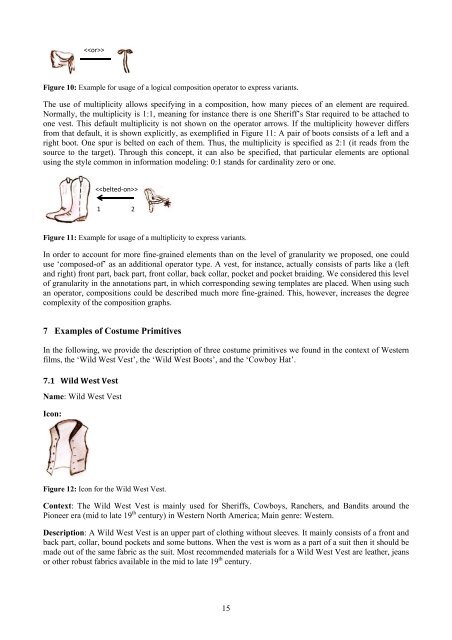A Pattern Language for Costumes in Films - IAAS
A Pattern Language for Costumes in Films - IAAS
A Pattern Language for Costumes in Films - IAAS
You also want an ePaper? Increase the reach of your titles
YUMPU automatically turns print PDFs into web optimized ePapers that Google loves.
Figure 10: Example <strong>for</strong> usage of a logical composition operator to express variants.<br />
The use of multiplicity allows specify<strong>in</strong>g <strong>in</strong> a composition, how many pieces of an element are required.<br />
Normally, the multiplicity is 1:1, mean<strong>in</strong>g <strong>for</strong> <strong>in</strong>stance there is one Sheriff’s Star required to be attached to<br />
one vest. This default multiplicity is not shown on the operator arrows. If the multiplicity however differs<br />
from that default, it is shown explicitly, as exemplified <strong>in</strong> Figure 11: A pair of boots consists of a left and a<br />
right boot. One spur is belted on each of them. Thus, the multiplicity is specified as 2:1 (it reads from the<br />
source to the target). Through this concept, it can also be specified, that particular elements are optional<br />
us<strong>in</strong>g the style common <strong>in</strong> <strong>in</strong><strong>for</strong>mation model<strong>in</strong>g: 0:1 stands <strong>for</strong> card<strong>in</strong>ality zero or one.<br />
<br />
1 2<br />
Figure 11: Example <strong>for</strong> usage of a multiplicity to express variants.<br />
In order to account <strong>for</strong> more f<strong>in</strong>e-gra<strong>in</strong>ed elements than on the level of granularity we proposed, one could<br />
use ‘composed-of’ as an additional operator type. A vest, <strong>for</strong> <strong>in</strong>stance, actually consists of parts like a (left<br />
and right) front part, back part, front collar, back collar, pocket and pocket braid<strong>in</strong>g. We considered this level<br />
of granularity <strong>in</strong> the annotations part, <strong>in</strong> which correspond<strong>in</strong>g sew<strong>in</strong>g templates are placed. When us<strong>in</strong>g such<br />
an operator, compositions could be described much more f<strong>in</strong>e-gra<strong>in</strong>ed. This, however, <strong>in</strong>creases the degree<br />
complexity of the composition graphs.<br />
7 Examples of Costume Primitives<br />
In the follow<strong>in</strong>g, we provide the description of three costume primitives we found <strong>in</strong> the context of Western<br />
films, the ‘Wild West Vest’, the ‘Wild West Boots’, and the ‘Cowboy Hat’.<br />
7.1 Wild West Vest<br />
Name: Wild West Vest<br />
Icon:<br />
Figure 12: Icon <strong>for</strong> the Wild West Vest.<br />
Context: The Wild West Vest is ma<strong>in</strong>ly used <strong>for</strong> Sheriffs, Cowboys, Ranchers, and Bandits around the<br />
Pioneer era (mid to late 19 th century) <strong>in</strong> Western North America; Ma<strong>in</strong> genre: Western.<br />
Description: A Wild West Vest is an upper part of cloth<strong>in</strong>g without sleeves. It ma<strong>in</strong>ly consists of a front and<br />
back part, collar, bound pockets and some buttons. When the vest is worn as a part of a suit then it should be<br />
made out of the same fabric as the suit. Most recommended materials <strong>for</strong> a Wild West Vest are leather, jeans<br />
or other robust fabrics available <strong>in</strong> the mid to late 19 th century.<br />
15
















